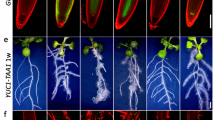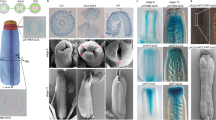Abstract
The coordination of cell polarity within the plane of a single tissue layer (planar polarity) is a crucial task during development of multicellular organisms. Mechanisms underlying establishment of planar polarity, however, differ substantially between plants and animals1,2,3. In Arabidopsis thaliana, planar polarity of root-hair positioning along epidermal cells is coordinated towards maximum concentration of an auxin gradient in the root tip3,4,5. This gradient has been hypothesized to be sink-driven6 and computational modelling suggests that auxin efflux carrier activity may be sufficient to generate the gradient in the absence of auxin biosynthesis in the root7. Here, we demonstrate that the Raf-like kinase CONSTITUTIVE TRIPLE RESPONSE1 (CTR1; Refs 8, 9) acts as a concentration-dependent repressor of a biosynthesis-dependent auxin gradient that modulates planar polarity in the root tip. We analysed auxin biosynthesis and concentration gradients in a variety of root-hair-position mutants affected in CTR1 activity, auxin biosynthesis and transport. Our results reveal that planar polarity relies on influx- and efflux-carrier-mediated auxin redistribution from a local biosynthesis maximum. Thus, a local source of auxin biosynthesis contributes to gradient homeostasis during long-range coordination of cellular morphogenesis.
This is a preview of subscription content, access via your institution
Access options
Subscribe to this journal
Receive 12 print issues and online access
$209.00 per year
only $17.42 per issue
Buy this article
- Purchase on Springer Link
- Instant access to full article PDF
Prices may be subject to local taxes which are calculated during checkout





Similar content being viewed by others
References
Zallen, J. A. Planar polarity and tissue morphogenesis. Cell 129, 1051–1063 (2007).
Adler, P. N. Planar signaling and morphogenesis in Drosophila. Dev. Cell 2, 525–535 (2002).
Grebe, M. Ups and downs of tissue and planar polarity in plants. Bioessays 26, 719–729 (2004).
Sabatini, S. et al. An auxin-dependent distal organizer of pattern and polarity in the Arabidopsis root. Cell 99, 463–472 (1999).
Fischer, U. et al. Vectorial information for Arabidopsis planar polarity is mediated by combined AUX1, EIN2, and GNOM activity. Curr. Biol. 16, 2143–2149 (2006).
Friml, J. et al. AtPIN4 mediates sink-driven auxin gradients and root patterning in Arabidopsis. Cell 108, 661–673 (2002).
Grieneisen, V. A., Xu, J., Marée, A. F., Hogeweg, P. & Scheres, B. Auxin transport is sufficient to generate a maximum and gradient guiding root growth. Nature 449, 1008–1013 (2007).
Kieber, J. J., Rothenberg, M., Roman, G., Feldmann, K. A. & Ecker, J. R. CTR1, a negative regulator of the ethylene response pathway in Arabidopsis, encodes a member of the Raf family of protein kinases. Cell 72, 427–441 (1993).
Huang, Y., Li, H., Hutchison, C. E., Laskey, J. & Kieber, J. J. Biochemical and functional analysis of CTR1, a protein kinase that negatively regulates ethylene signaling in Arabidopsis. Plant J. 33, 221–233 (2003).
Molendijk, A. J. et al. Arabidopsis thaliana Rop GTPases are localized to tips of root hairs and control polar growth. EMBO J. 20, 2779–2788 (2001).
Jones, M. A. et al. The Arabidopsis Rop2 GTPase is a positive regulator of both root hair initiation and tip growth. Plant Cell 14, 763–776 (2002).
Carol, R. J. et al. A RhoGDP dissociation inhibitor spatially regulates growth in root hair cells. Nature 438, 1013–1016 (2005).
Masucci, J. D. & Schiefelbein, J. W. The rhd6 mutation of Arabidopsis thaliana alters root hair initiation through an auxin- and ethylene-associated process. Plant Physiol. 106, 1335–1346 (1994).
Swarup, R. et al. Structure-function analysis of the presumptive Arabidopsis auxin permease AUX1. Plant Cell 16, 3069–3083 (2004).
Yang, Y., Hammes, U. Z., Taylor, C. G., Schachtman, D. P. & Nielsen, E. High-affinity auxin transport by the AUX1 influx carrier protein. Curr. Biol. 16, 1123–1127 (2006).
Alonso, J. M., Hirayama, T., Roman, G., Nourizadeh, S. & Ecker, J. R. EIN2, a bifunctional transducer of ethylene and stress responses in Arabidopsis. Science 284, 2148–2152 (1999).
Steinmann, T. et al. Coordinated polar localization of auxin efflux carrier PIN1 by GNOM ARF GEF. Science 286, 316–318 (1999).
Kleine-Vehn, J. et al. ARF GEF-dependent transcytosis and polar delivery of PIN auxin carriers in Arabidopsis. Curr. Biol. 18, 526–531 (2008).
Rashotte, A. M., DeLong, A. & Muday, G. K. Genetic and chemical reductions in protein phosphatase activity alter auxin transport, gravity response, and lateral root growth. Plant Cell 13, 1683–1697 (2001).
Swarup, R. et al. Root gravitropism requires lateral root cap and epidermal cells for transport and response to a mobile auxin signal. Nature Cell Biol. 7, 1057–1065 (2005).
Müller, A. et al. AtPIN2 defines a locus of Arabidopsis for root gravitropism control. EMBO J. 17, 6903–6911 (1998).
Geisler, M. & Murphy, A. S. The ABC of auxin transport: the role of p-glycoproteins in plant development. FEBS Lett. 580, 1094–1102 (2006).
Ljung, K. et al. Sites and regulation of auxin biosynthesis in Arabidopsis roots. Plant Cell 17, 1090–1104 (2005).
Tao, Y. et al. Rapid synthesis of auxin via a new tryptophan-dependent pathway is required for shade avoidance in plants. Cell 133, 164–176 (2008).
Cheng, Y., Dai, X. & Zhao, Y. Auxin biosynthesis by the YUCCA flavin monooxygenases controls the formation of floral organs and vascular tissues in Arabidopsis. Genes Dev. 20, 1790–1799 (2006).
Stepanova, A. N., Hoyt, J. M., Hamilton, A. A. & Alonso, J. M. A link between ethylene and auxin uncovered by the characterization of two root-specific ethylene-insensitive mutants in Arabidopsis. Plant Cell 17, 2230–2242 (2005).
Stepanova, A. N. et al. TAA1-mediated auxin biosynthesis is essential for hormone crosstalk and plant development. Cell 133, 177–191 (2008).
Geldner, N. et al. Partial loss-of-function alleles reveal a role for GNOM in auxin transport-related, post-embryonic development of Arabidopsis. Development 131, 389–400 (2004).
Roman, G., Lubarsky, B., Kieber. J. J., Rothenberg, M. & Ecker, J. R. Genetic analysis of ethylene signal transduction in Arabidopsis thaliana: five novel mutant loci integrated into a stress response pathway. Genetics 139, 1393–1409 (1995).
Swarup, R. et al. Ethylene upregulates auxin biosynthesis in Arabidopsis seedlings to enhance inhibition of root cell elongation. Plant Cell 19, 2186–2196 (2007).
Růzicka, K. et al. Ethylene regulates root growth through effects on auxin biosynthesis and transport-dependent auxin distribution. Plant Cell 19, 2197–2212 (2007).
Bhalerao, R. P. et al. Shoot-derived auxin is essential for early lateral root emergence in Arabidopsis seedlings. Plant J. 29, 325–332 (2002).
Friml, J. et al. Efflux-dependent auxin gradients establish the apical-basal axis of Arabidopsis. Nature 426, 147–153 (2003).
Xu, J. & Scheres, B. Dissection of Arabidopsis ADP-RIBOSYLATION FACTOR 1 function in epidermal cell polarity. Plant Cell 17, 525–536 (2005).
Men, S. et al. Sterol-dependent endocytosis mediates post-cytokinetic acquisition of PIN2 auxin efflux carrier polarity. Nature Cell Biol. 10, 237–244 (2008).
Acknowledgements
We gratefully acknowledge M. Bennett, J. Ecker, M. Estelle, J. Friml, G. Jürgens, K. Palme, B. Scheres, R. Swarup and J. Xu for sharing published research materials used in this study. We are grateful to R. Granbom for tissue preparation and technical assistance with auxin concentration and biosynthesis-rate measurements. We thank L. Bako for valuable advice on protein kinase assays, as well as C. Bellini, R. Bhalerao, Y. Boutté, A. Claes, S. Pietra, M. Rosa and B. Sundberg for helpful comments on the manuscript. This work was supported by grants from the Swedish Research Council (Vetenskapsrådet) and the Swedish Foundation for Strategic Research (SSF) to M.G., by an EU Marie-Curie International Incoming Postdoctoral Fellowship to Y.I, and by NSF grants (MCB 0519869, MCB 0315992) to J.M.A.
Author information
Authors and Affiliations
Contributions
M.G., Y.I. and K.L. conceived the project; Y.I., K.L. and M.G. designed, performed and analysed the experiments apart from PIN2 localization in gnom mutants, which were carried out by U.F., ROP localization, auxin-bead-application as well as YFP–AUX1 and PIN2–EGFP colocalization experiments, which were performed by S.M., analysed and interpreted by U.F., S.M., Y.I., and M.G.; A.N.S. and J.M.A. provided valuable experimental materials and advice; M.G. and Y.I. wrote the paper. All authors contributed to the interpretation of results and edited the manuscript.
Corresponding author
Ethics declarations
Competing interests
The authors declare no competing financial interests.
Supplementary information
Supplementary Information
Supplementary Information (PDF 1392 kb)
Rights and permissions
About this article
Cite this article
Ikeda, Y., Men, S., Fischer, U. et al. Local auxin biosynthesis modulates gradient-directed planar polarity in Arabidopsis. Nat Cell Biol 11, 731–738 (2009). https://doi.org/10.1038/ncb1879
Received:
Accepted:
Published:
Issue Date:
DOI: https://doi.org/10.1038/ncb1879
This article is cited by
-
Novel insights into maize (Zea mays) development and organogenesis for agricultural optimization
Planta (2023)
-
Genome-wide dissection of changes in maize root system architecture during modern breeding
Nature Plants (2022)
-
Genetic and epigenetic modes of the regulation of somatic embryogenesis: a review
Biologia Futura (2022)
-
Emerging functions of chromatin modifications in auxin biosynthesis in response to environmental alterations
Plant Growth Regulation (2019)
-
Regulation of seedling growth by ethylene and the ethylene–auxin crosstalk
Planta (2017)



